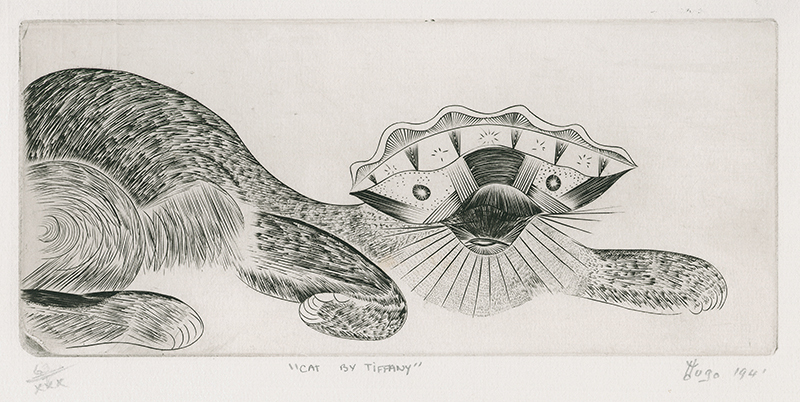
19th, 20th & 21st Century Fine Prints
707-546-7352 · fax 707-546-7924 · web: www.annexgalleries.com · email: artannex@aol.com
Cat By Tiffany by Ian Hugo

Cat By Tiffany
Ian Hugo
Cat By Tiffany
Ian Hugo
1898 - 1985 (biography)Hugo used a burin to "draw" directly on the surface of the copper plate. The composition itself evokes many emerging surreal, dreamlike images.
"Cat by Tiffany", like many of the Atelier 17 experimental prints, was done using engraving to incise the sharp lines and textures into the copper plate. This composition is Hugo's whimsical creation of a cat with its head designed as a piece of jewelry by Tiffany.
Ian Hugo was born Hugh Parker Guiler in Boston, Massachusetts on February 15, 1898. His childhood was spent in Puerto Rico ("a tropical paradise") the memory of which stayed with him and surfaced in both his engravings and his films, but he attended school in Scotland and graduated from Columbia University where he studied economics and literature.
He was working with the National City Bank when he met and married author Anais Nin in 1923. They moved to Paris the following year where Nin's diary and Guiler's artistic aspirations flowered. Guiler feared his business associates would not understand his interests in art and music, let alone those of the controversial Anais, so he began a second life as 'Ian Hugo'. Ian and Anais moved to New York in 1939. The following year he took up engraving and etching, working at Stanley William Hayter’s Atelier 17, established at the New School for Social Research.
Hugo was one the the early printmakers to help establish the Atelier 17 in New York with Hayter, who he had known in Paris. Hugo wanted to learn engraving so he could illustrate Anaïs Nin's books which they were self publishing, unable to find a publisher willing to take a chance.
Hugo began producing the surreal images that often accompanied Nin's books. For Nin, his unwavering love and financial support were indispensable, Hugo was "the fixed center, core...my home, my refuge" (Sept. 16, 1937, Nearer the Moon, The Unexpurgated Diary of Anaïs Nin, 1937-1939). A partially fictionalized portrait of Hugo appears in Philip Kaufman's 1990 film, 'Henry & June'.
Hugo began working at Atelier 17 in 1940 and he quickly mastered the technique of engraving. There are numerous state proofs for Cat by Tiffany but there is no catalogue raisonné on the artist to reference the exact number of states of the plate. Hugo was obviously new to editioning as he erased part of his edition number and then corrected it to read 6/XXX.
In her foreword for Ten Engravings: Ian Hugo, Anaïs Nin wrote: "Ian Hugo learned the technique of line engraving on copper at Atelier 17, under Stanley William Hayter, but as an artist he is essentially self taught. These engravings began as unconscious “doodling;” the doodling became an unpremeditated pressure on the engraving tool. Amazing and unexpected figures appeared. The lines have the purity and simplicity of cave drawings. The sign of the true artist is one who creates a complete universe, invents new plants, new animals, new figures to transfer to us a new vision of the universe in which dream and reality fuse. Ian Hugo’s plants have eyes, the birds have the delicacy of dragonflies, their feathers have the shape of fans. Humor is apparent in every gesture. He uses a fine spider web to give a feeling of flight, speed, lightness. The body of a woman reveals the structure of a leaf, a plant. Wings are moving in a world unified by mythological themes. This is an animated world, humorous and levitating, elusive and decorative, which by its unique forms and shapes gives us the sensation of a rebirth, a liberation from the usual, the familiar, a visit to a new planet."
Responding to comments that viewers saw motion in his engravings, Hugo chose to take up filmmaking. He asked Sasha Hammid for instruction and was advised:
“Use the camera yourself, make your own mistakes, make your own style.” Hugo delved into his dreams, his unconscious, and his memories. With no specific plan when he began a film, Hugo would collect images, then reorder or superimpose them, finding poetic meaning in these juxtapositions. These spontaneous inventions greatly resembled his engravings, which he described in 1946 as “hieroglyphs of a language in which our unconscious is trying to convey important, urgent messages.” In the underwater world of his film, Bells of Atlantis, all of the light is from the world above the surface; it is otherworldly, out of place yet necessary. In Jazz of Lights, the street lights of Times Square become in Nin's words, “an ephemeral flow of sensations.” This flow that she also called “phantasmagorical” had a crucial impact on filmmaker Stan Brakhage who stated that without Jazz of Lights (1954) “there would have been no Anticipation of the Night.” Hugo produced fifteen films between the 1946 and 1979.Hugo lived the last two decades of his life in a New York apartment high above street level. In the evenings, surrounded by an electrically illuminated landscape, he dictated his memoirs into tape recorders and would from time to time polish the large copper plates that had been used to print his engravings from the worlds of the unconscious and the dream.
Ian Hugo died in Manhattan, New York City on January 7, 1985.
